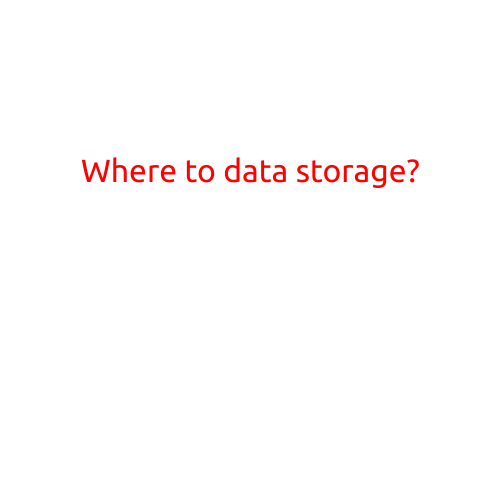
Where to Store Your Data: A Comprehensive Guide
In today’s digital age, data storage has become a vital concern for individuals and organizations alike. With the ever-growing amount of data being generated, storing and managing it effectively is crucial to ensure seamless operations and maintain data integrity. Choosing the right data storage option can be daunting, but this article aims to guide you through the various options available, their benefits, and considerations.
Cloud Storage
Cloud storage is a popular and convenient option for storing data. It offers several advantages, including:
- Scalability: Cloud storage can scale up or down as per your requirements, making it an ideal choice for businesses with fluctuating data needs.
- Accessibility: Cloud storage allows you to access your data from anywhere, at any time, on any device with an internet connection.
- Cost-effective: Cloud storage often offers a pay-as-you-go pricing model, which can be more cost-effective than investing in on-premises storage solutions.
- Data backup and recovery: Cloud storage providers often offer automatic backup and disaster recovery services, ensuring your data is safe and easily recoverable.
Some popular cloud storage options include:
- Amazon S3
- Microsoft Azure
- Google Cloud Storage
- Dropbox
- iCloud
On-Premises Storage
On-premises storage refers to storing data within your organization’s premises, often on local servers or storage devices. This option offers:
- Control: With on-premises storage, you have complete control over your data, ensuring compliance with regulatory requirements and maintaining data sovereignty.
- Security: On-premises storage provides an additional layer of security, as data is stored within your organization’s network and is less susceptible to cyber threats.
- No dependence on internet: On-premises storage allows you to access your data without relying on an internet connection.
However, on-premises storage also has its limitations, including:
- Initial investment: Installing and configuring on-premises storage solutions can be costly.
- Maintenance and upgrades: You’ll be responsible for regular maintenance and upgrades, which can be time-consuming and require technical expertise.
Some popular on-premises storage options include:
- Hard disk drives (HDDs)
- Solid-state drives (SSDs)
- Hybrid storage arrays
- NAS (Network-Attached Storage) devices
Hybrid Storage
Hybrid storage combines the benefits of cloud and on-premises storage by storing data both locally and remotely. This option offers:
- Flexibility: Hybrid storage allows you to choose the best storage option for different types of data, depending on its requirements.
- Scalability: Hybrid storage can scale up or down as per your needs, ensuring you’re always prepared for future growth or changes.
- Disaster recovery: Hybrid storage solutions often provide automatic backup and disaster recovery services, ensuring your data is safe and easily recoverable.
Some popular hybrid storage options include:
- Cloud-connected NAS devices
- Hybrid cloud storage solutions
- Distributed storage platforms
Conclusion
Choosing the right data storage solution depends on your organization’s specific needs, goals, and constraints. When deciding where to store your data, consider the factors mentioned above, including scalability, accessibility, cost-effectiveness, control, security, and maintenance requirements. By understanding the pros and cons of each option, you can make an informed decision that meets your data storage needs and ensures the integrity of your valuable data.
Additional Tips
- Assess your data: Understand your data storage requirements and categorize your data into different classes, such as sensitive, confidential, or public.
- Evaluate storage options: Research and evaluate different storage options, considering factors like cost, scalability, and security.
- Develop a data storage strategy: Create a comprehensive data storage strategy that outlines your storage requirements, backup and disaster recovery procedures, and data management protocols.
- Monitor and maintain: Regularly monitor your data storage solution and perform routine maintenance tasks to ensure optimal performance and data integrity.





